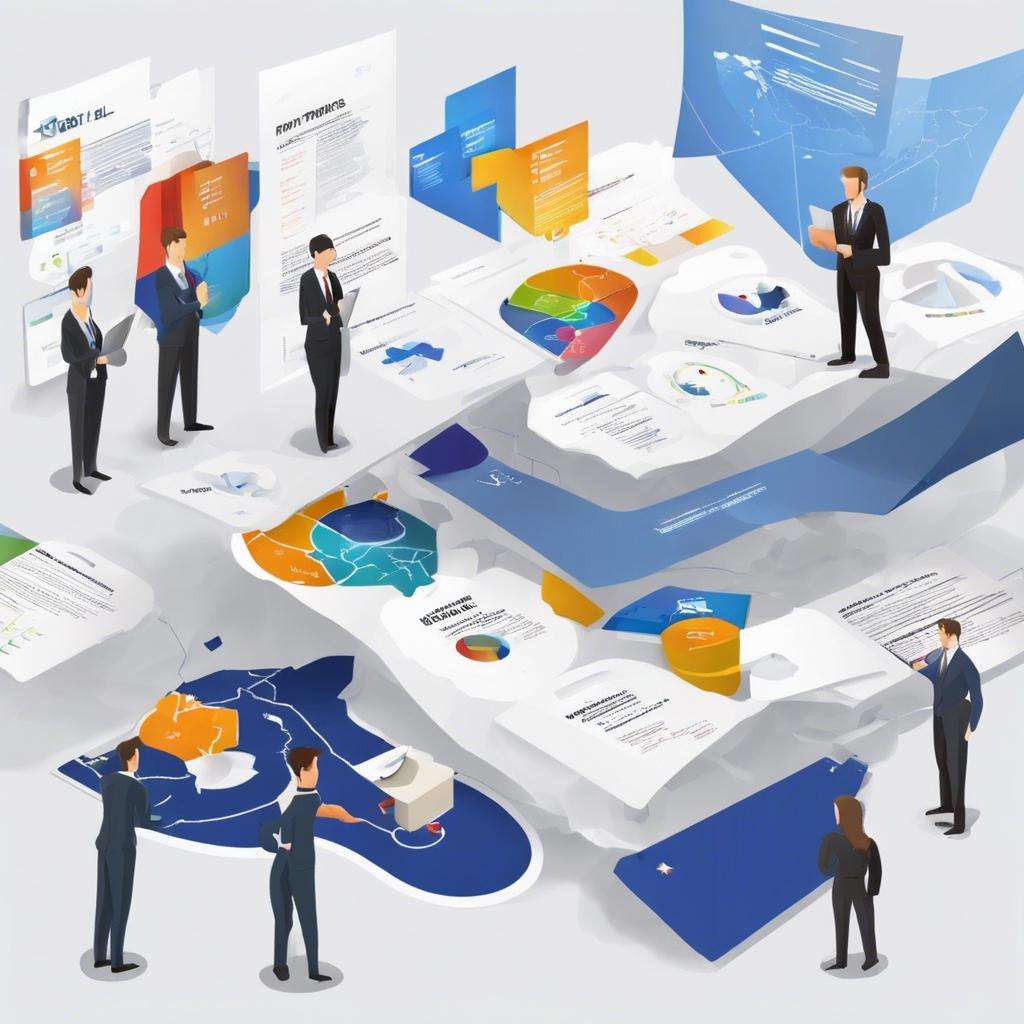Europe's Economic Landscape: Navigating Challenges and Opportunities
The economic landscape of Europe is currently a dynamic mix of challenges and opportunities. With the aftermath of the pandemic still influencing markets, inflation rates have surged, prompting central banks to reassess their monetary policies.
Countries like Germany, France, and Italy are facing varying rates of growth, reflecting their unique industrial strengths and consumer behaviors.
Moreover, the ongoing geopolitical tensions are reshaping trade relations and energy supplies, particularly with Russia. The EU is focusing on achieving energy independence and enhancing sustainable practices, aiming for a greener economy.
Digital transformation is another critical focus as businesses pivot to technology-driven solutions, boosting productivity. Despite these hurdles, the European Union's unified approach provides a strong foundation for resilience, enabling member states to collaborate on fiscal stability and economic recovery strategies.
The future holds promise as innovation and adaptability shape Europe's economic path forward.
Navigating Challenges: The Future of Europe's Economic Growth
As we look towards the future, Europe stands at a crossroads in its economic journey, confronting a myriad of challenges that could significantly impact its growth trajectory. From geopolitical tensions to environmental sustainability, Europe's response to these pressing issues will determine its economic resilience in the coming decades.
The Impact of Geopolitical Tensions
Geopolitical stability is a cornerstone of economic growth. Europe's proximity to regions such as Eastern Europe and the Middle East introduces complexities that can hinder trade and investment. The ongoing conflict in Ukraine and fluctuating relations with Russia highlight the need for Europe to diversify energy sources and reduce its dependence on external powers. This diversification could not only enhance energy security but also stimulate local economies through investments in renewable energy technologies.
Technological Innovation: The Key to Competitiveness
In an age defined by rapid technological advancement, Europe must foster an environment conducive to innovation. Investment in research and development, particularly in sectors like artificial intelligence, green technologies, and biotechnology, is crucial. By prioritizing education and cultivating a skilled workforce, Europe can position itself as a global leader in these transformative industries.
Demographic Challenges and Opportunities
Europe faces significant demographic challenges, including an aging population and declining birth rates. However, these challenges also present opportunities for economic growth. Embracing immigration can help to fill skill gaps in the workforce and stimulate growth in various sectors. Furthermore, promoting inclusive policies that support family growth and work-life balance could lead to a revitalized labor market.
Environmental Sustainability and the Green Economy
With climate change at the forefront of global concerns, Europe's commitment to sustainability will shape its economic future. The transition to a circular economy provides an opportunity for growth through innovation in sustainable practices, resource efficiency, and waste reduction. Initiatives like the European Green Deal aim to lead the world in environmentally friendly policies, positioning Europe as a hub for green jobs and technologies.
Addressing Economic Disparities
Economic disparities within and between European countries can impede overall growth. Structural reforms that support regional development are vital to ensuring that all regions can contribute to and benefit from economic prosperity. Investing in infrastructure, education, and local enterprises in underdeveloped areas can stimulate economic activity and create a more balanced economic landscape.
Conclusion: A Collaborative Path Forward
As Europe navigates these multifaceted challenges, a collaborative approach will be essential. By leveraging the strengths of its member states and fostering unity in policy-making, Europe can enhance its resilience and competitiveness. The future of Europe's economic growth hinges on its ability to adapt, innovate, and embrace change while remaining committed to shared values of sustainability, inclusivity, and collaboration.
Only through comprehensive strategies that address these challenges can Europe hope to secure a prosperous and sustainable economic future for generations to come.


Inflation Insights: Understanding Shifting Prices Across Europe
Inflation, a term that frequently appears in economic discussions, signifies the rate at which the general level of prices for goods and services rises, leading to a decrease in purchasing power. In recent years, Europe has experienced significant fluctuations in inflation rates, prompting both policymakers and consumers to take notice. Understanding these changes is essential for navigating the complex economic landscape of the continent.
Current Trends in European Inflation
As of late 2023, inflation rates across Europe have shown considerable variability. Countries in the Eurozone have witnessed annual inflation rates ranging from less than 2% to upwards of 10%. This disparity can be attributed to various factors including energy prices, supply chain disruptions, and differing monetary policies among member states.
Factors Influencing Inflation in Europe
1. Energy Prices: Energy costs remain a crucial driver of inflation in Europe. The volatility in oil and gas prices, exacerbated by geopolitical tensions and the shift towards renewable energy sources, contrasts heavily with consumer expectations and spending habits.
2. Supply Chain Disruptions: Post-pandemic recovery has revealed fragile supply chains across Europe. Delays in transportation and production bottlenecks have contributed to price increases, particularly in sectors like electronics, automotive, and construction.
3. Monetary Policy: The European Central Bank (ECB) has taken a proactive stance in managing inflation through interest rate adjustments. As rates rise to combat inflation, the resultant impact on consumer spending and borrowing costs further complicates economic dynamics.
Regional Variations
While certain trends are observable at the continental level, significant regional variations exist. For example:
- Western Europe: Countries like Germany and France have historically maintained lower inflation rates due to stabilized economies and effective policy measures.
- Southern Europe: Nations such as Spain and Italy have seen higher inflation rates, often linked to tourism and seasonal economic fluctuations, which are sensitive to external shocks.
- Eastern Europe: Recent increases in energy costs have hit countries like Hungary and Poland hard, causing inflationary pressures that affect basic goods and services.
Impact on Consumers and Businesses
The ripple effects of inflation are felt across all sectors of society. Consumers face increased prices for essentials, prompting a shift in spending habits. Many individuals are seeking strategies to manage their budgets effectively by prioritizing needs over wants.
On the other hand, businesses must adapt to changing costs of production and materials. Higher inflation often squeezes profit margins, which can lead to increased prices for consumers or, alternatively, reduced investment in growth and innovation.
What's Ahead? Future Projections
Looking ahead, experts remain divided on inflation's trajectory across Europe. Some predict that as supply chains stabilize and energy prices moderate, inflation rates will gradually decline toward pre-pandemic levels. Others caution that ongoing geopolitical tensions and policy shifts may prolong high inflation rates, necessitating continued vigilance from consumers and policymakers alike.
Conclusion
Understanding the intricacies of inflation in Europe requires a nuanced view of multiple economic factors and regional contexts. As prices continue to shift, staying informed about trends and forecasts will empower consumers and businesses to navigate an increasingly complex economic landscape. By adapting to new realities and planning for the future, stakeholders across Europe can strive toward stability in uncertain times.
Investment Trends: Where to Put Your Money in Europe's Evolving Market
The European investment landscape is undergoing a remarkable transformation, influenced by technological advancements, sustainability initiatives, and changing consumer preferences. As traditional investment strategies evolve, identifying emerging sectors and trends is crucial for optimizing returns. This article explores key investment trends in Europe, highlighting opportunities where savvy investors can place their money for maximum impact.
The Rise of Sustainable Investing
Sustainability has shifted from being a niche market to a core consideration for investors across Europe. As governments implement stricter regulations on carbon emissions and financial institutions adopt Environmental, Social, and Governance (ESG) criteria, sustainable investment is gaining traction. Investors can explore renewable energy projects, green bonds, and companies with healthy sustainability practices, positioning themselves for long-term growth while contributing positively to the planet.
Technological Innovation and FinTech
Europe's standing as a hub for technological innovation, particularly in the financial sector, makes it a hotspot for investment. The FinTech sector is booming, with offerings ranging from peer-to-peer lending platforms to cryptocurrency exchanges. Startups in cities like London, Berlin, and Amsterdam are attracting significant VC funding, providing investors with exciting opportunities to capitalize on the digital finance revolution. Additionally, developments in artificial intelligence (AI) and blockchain technology are paving the way for groundbreaking applications across various industries.
Healthcare and Biotech Investments
The healthcare sector, particularly biotech, has proven its resilience and growth potential, especially in light of the recent global health crisis. Innovative companies focused on drug development, telemedicine, and medical devices are attracting increased investment. As an aging population requires better healthcare solutions, investors should keep a keen eye on emerging therapies and technologies that promise high returns.
Renewable Energy and Infrastructure Projects
With the EU's commitment to achieving net-zero emissions by 2050, investment in renewable energy and infrastructure is set to surge. Wind, solar, and other green technologies are not only supported by governmental policies but also backed by private investment. Infrastructure projects, such as enhanced public transport systems and energy-efficient buildings, are essential for a sustainable future, making them viable areas for investment. Investors should consider dedicating funds to these forward-thinking projects that align with global sustainability goals.
Real Estate: Shifting Preferences
The real estate market in Europe is witnessing a shift influenced by remote work trends and changing lifestyle preferences. Urban areas with a strong tech presence are seeing increased demand for residential and commercial properties even as remote work becomes more normalized. Investors are finding opportunities in logistics hubs due to the rise of e-commerce, spurring demand for warehouse spaces. Furthermore, emerging trends such as co-living and co-working spaces offer new investment avenues catering to changing demographics.
ESG: A Mandate, Not a Market Trend
Understanding ESG factors is vital not only for ethical investing but also for risk management. Companies prioritizing ESG principles are likely to outperform their peers in the long run. Investors should integrate ESG criteria into their investment processes, honing in on firms that demonstrate a commitment to sustainable practices. The increasing demand for transparency and accountability will drive a growing number of businesses to adopt these principles, making ESG-focused investments a prudent choice.
Conclusion: Navigating the Evolving Market
As Europe’s investment landscape continues to shift, staying informed about current trends is essential for making sound investment decisions. From sustainable initiatives to technological advancements and healthcare innovations, a multitude of opportunities awaits. By aligning investment strategies with these trends, investors can not only achieve substantial returns but also contribute to defining a more sustainable and innovative future for Europe.
Invest wisely, stay agile, and remember: the best investments are those that reflect both your financial goals and your values in today’s evolving economic environment.

